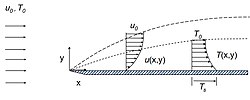In physics and fluid mechanics, a boundary layer is the thin layer of fluid in the immediate vicinity of a bounding surface formed by the fluid flowing...
49 KB (7,678 words) - 19:57, 6 June 2024
thickness and shape of boundary layers formed by fluid flowing along a solid surface. The defining characteristic of boundary layer flow is that at the solid...
29 KB (4,792 words) - 21:57, 11 April 2024
In meteorology, the planetary boundary layer (PBL), also known as the atmospheric boundary layer (ABL) or peplosphere, is the lowest part of the atmosphere...
21 KB (2,073 words) - 13:30, 30 April 2024
Boundary layer control refers to methods of controlling the behaviour of fluid flow boundary layers. It may be desirable to reduce flow separation on...
9 KB (1,196 words) - 07:24, 11 February 2024
mechanics, a Blasius boundary layer (named after Paul Richard Heinrich Blasius) describes the steady two-dimensional laminar boundary layer that forms on a...
21 KB (3,616 words) - 20:04, 14 January 2024
thermal boundary layer formed by a heated (or cooled) fluid moving along a heated (or cooled) wall. In many ways, the thermal boundary layer description...
11 KB (1,864 words) - 23:35, 9 February 2024
Boundary layer suction is a boundary layer control technique in which an air pump is used to extract the boundary layer at the wing or the inlet of an...
4 KB (468 words) - 19:24, 10 June 2022
Flow separation (redirect from Boundary layer separation)
flow separation or boundary layer separation is the detachment of a boundary layer from a surface into a wake. A boundary layer exists whenever there...
9 KB (1,131 words) - 00:39, 17 April 2024
500–1,800 K hotter than the overlying mantle, creating a thermal boundary layer. The boundary is thought to harbor topography, much like Earth's surface, that...
9 KB (943 words) - 04:28, 7 March 2024
Laminar–turbulent transition (redirect from Boundary layer transition)
applies to any fluid flow, and is most often used in the context of boundary layers. In 1883 Osborne Reynolds demonstrated the transition to turbulent...
12 KB (1,607 words) - 04:13, 10 February 2024





